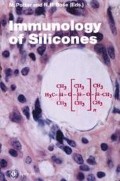Abstract
Silicone (polydimethylsiloxane, PDMS) is generally a very stable polymer. Because of this, it is used in a wide variety of adverse environments such as those with high temperature or as electrical insulation. However, a great deal of this stability derives from the fact that hydrolysis reactions which occur are reversible and the polymer essentially heals itself. It is likely that such reversibility would not occur in the surface region where high concentrations of other components, such as water, can exist. Because of the significant concern about the fate of silicone released from breast implants in particular, it is important to understand the types of chemical changes which may occur in silicone upon exposure to physiological environments so that the data on various silicon-containing species can be correlated with other physiological studies on known compounds. Accordingly, this chapter will focus on the known silicone degradation reactions which occur within normal physiological ranges (37° and mixed aqueous environment). Various other studies will be drawn upon to evaluate the possible changes since the literature on silicone modification under physiological situations is sparse at this time. Three main reactions discussed are hydrolysis, oxidation, and addition.
Chris Batich has worked with attorneys representing women in suits against some manufacturers
Access this chapter
Tax calculation will be finalised at checkout
Purchases are for personal use only
Preview
Unable to display preview. Download preview PDF.
References
Barton, T. and P. Boudjouk, “Organosilicon Chemistry,” Ch. 1 in Silicone-Based Polymer Science, Amer. Chem. Soc. (1990), ed. J. Zeigler and F. Fearon.
Bergman, R., A. van der Ende, “Exudation of Silicone Through the Envelope of Gel-Filled Prostheses: An In Vitro Study,” Brit J. Plast. Surg., 32:31–34, 1979.
Brody, G., “Fact and Fiction About Breast Implant ‘Bleed,’” (Editorial), Plast. Reconstr. Surg. 30:615–616, 1977.
Haggard, W., J. Lemons, J. Mays, C. Prince, “Investigation of Cellular Responses to the Components of Silicone Gel Sheeting,” Abstract Society For Biomaterials Proceedings, 280, 1993.
Hiemenz, P., “Principles of Colloid and Surface Chemistry,” 2nd ed. (1986), Marcel Dekker, New York, NY, p. 7.
Kingery, W., H. Bowen, D. Uhlmann, Introduction to Ceramics. 2nd ed., John Wiley & Sons, 1976.
LeVier, R., et al., “What is Silicone?” Plast. Recon. Surg. 92, 163–167 (1993).
Martellock, A., “The Hydrolytic Degradation of Silicone Polymers,” Elastoplastics Technology Conf., March 24, 1966.
Mathews, C. and K. van Holde, Biochemistry, Benjamin/Cummings Pub., Redwood City, CA (1990), p. 287.
McCoy, S., “Factors Affecting the Integrity and Stability of Q7-2159A Mammary Gel and Intermediates,” Dow-Corning Quality Assurance Report, April 1, 1987.
Nairn, J., et al., “The Adjuvant Effect of Silicone-Gel on Antibody Formation in Rats,” Immun. Invest., 22, 151–161 (1993).
Osthoff, R., et al., “Chemical Stress Relaxation of PDMS Elastomers,” J. Amer. Chem. Soc, 76, 4659 (1954).
Razzaboni, B. and P. Bolsaitis, “Evidence of an Oxidative Mechanism for the Hemolytic Activity of Silica Particles,” Environ. Health Persp. 87, 337–341 (1990).
Ritter, J., Crack Propagation in Ceramics in Engineered Materials Handbook, Vol. 4, Ceramics and Glasses, ASM International, 1991.
Saam, J., “Formation of Linear Siloxane Polymers,” Chapter 3 in Silicone-Based Polymer Science, Amer. Chem. Soc. (1990), ed. J. Zeigler and F. Fearon.
Shi, X., et al., “The Chemical Properties of Silica Particle Surface in Relation to Silica-Cell Interactions,” J. Tox. Env. Health, 27, 435–454 (1989).
Towns, J. and F. Regnier, J. Chromotog. 516, 69–78 (1990).
Varaprath, S., memo to R. LeVier, “Composition Analysis of Mammary Gel Bleed,” Internal Dow-Corning Wright Study, June 19, 1991.
Vondracek, P. and A. Gent, “Slow Decomposition of Silicone Rubber,” J. Appl. Polym. Sci., 27, 4517–4523 (1982).
Yu, L., G. LaTorre, J. Marotta, C. Batich, N. Hardt, “In Vitro Measurement of Silicone Bleed from Breast Implants,” Submitted for Publication, Plastic and Reconstructive Surgery.
Author information
Authors and Affiliations
Editor information
Editors and Affiliations
Rights and permissions
Copyright information
© 1996 Springer-Verlag Berlin Heidelberg
About this paper
Cite this paper
Batich, C., DePalma, D., Marotta, J., Latorre, G. (1996). Silicone Degradation Reactions. In: Potter, M., Rose, N.R. (eds) Immunology of Silicones. Current Topics in Microbiology and Immunology, vol 210. Springer, Berlin, Heidelberg. https://doi.org/10.1007/978-3-642-85226-8_2
Download citation
DOI: https://doi.org/10.1007/978-3-642-85226-8_2
Publisher Name: Springer, Berlin, Heidelberg
Print ISBN: 978-3-642-85228-2
Online ISBN: 978-3-642-85226-8
eBook Packages: Springer Book Archive

